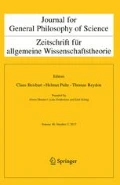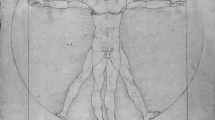Abstract
Since summer 2019 there is a new document that defines what in science should be regarded as being one second, one meter, and one kilogram, respectively. It is the ninth edition of the SI Brochure. Compared with older editions, a new definitional approach has been used. The seven base units are now defined by being directly related to a so-called defining constant. The paper discusses the second, the meter, and the kilogram. One odd salient, but nonetheless not discussed, feature of the formulations of the definitions is that, from a purely linguistic point of view, they are circular. That is, symbols for what is to be defined appear also in the defining expressions. However, underneath the circularities there are, appearances notwithstanding, substantially non-circular definitions. The aim of the paper is to uncover these never before presented definitional structures. It is made by means of the two notions absolutely discrete quantities (counts) and metrical coordinative definitions. When the true definitional structures become visible, two important substantial metrological facts can be seen. First, the new definition of the kilogram is very much in need of further discussion. Second, contrary to what the Brochure hints at, there is no need to try to exchange the atomic parameter used in the definition of the second.
Similar content being viewed by others
Notes
In what follows, quotations apart, I will unlike the SI publications use the spelling ‘meter’ not ‘metre’.
I write “so-called” because there is nothing in the structure of the SI9 that makes a distinction between base units and derived units natural. And this is explicitly stated: “Defining the SI by fixing the numerical values of seven defining constants has the effect that this distinction is, in principle, not needed, since all units, base as well as derived units, may be constructed directly from the defining constants. Nevertheless, the concept of base and derived units is maintained because it is useful and historically well established” (SI9, 129).
In an earlier paper, I use the distinction between discrete and continuous entities to clarify the distinction between stoichiometry and physics (Johansson 2011).
The distinction allows that an object may in some contexts be linguistically treated as if it is a property. In particular, this is true of component parts of an object. Think of oxygen. In itself it is an object (property bearer) with various physical and atomic properties. But in relation to the water molecule it may be treated as a property. Having an oxygen atom as a component part might be called a property of the molecule.
Much more can of course be said about the distinction made. Readers who find the notion of conceivability unproblematic, can regard entities that are conceivable (e.g. energy transport with a speed larger than c) as metaphysically possible but physically impossible, and entities that are inconceivable (e.g. round squares) as metaphysically impossible. Philosophers steeped in possible world-talk can equate the metaphysically possible with what exists in at least one possible world, and the metaphysically impossible with what does not exist in any possible world. I regard natural laws as delineating only nomological impossibilities, i.e., I can think of the laws as being false.
I have written more extensively about this in (Johansson 2010, Sect. 4).
The fact stated has a peculiar consequence that does not threaten anything else in the SI9, but I think had better be noted. The definition of the base unit the ampere relates it to the defining constant electric charge (e) and the unit coulomb (C). It is stipulated that 1 e = 1.602 176 634 × 10–19 C. This means, conversely, that 1 C = 1/1.602 176 634 × 1019 e. If we multiply both sides of the latter equality with 1.602 176 634 × 109 we get: 1 602 176 634 C = 1028 e. That is, 1 602 176 634 C is an integer multiple of e. But what about the very unit the coulomb? Can 1 C be an integer multiple of e? By simple arithmetic it can be shown that the answer is no, it cannot. Also, it can be made very probable that neither can a decimal multiple of the coulomb be an integer multiple of e. This means, if correct, that no single SI unit for electric charge (e.g. kC, TC or YC) can be realized. Non-decimal multiples (such as the realizable 1 602 176 634 C) are by the SI Brochure not allowed to be called SI units.
Reichenbach was not primarily interested in the kind of metrical definitions that I focus on, but on how to connect purely mathematical-geometrical concepts such as “straight line” and “congruence” with physical reality. He ended up in a kind of partial conventionalism with respect to the geometrical structure of the world, but I will not touch upon this conventionalism issue, even though this is what normally is discussed in relation to the term “coordinative definition”. That there is a conventional element in the definitions of the second, the meter, and the kilogram no one has doubted. I have used the notion of coordinative definition earlier (Johansson 2009; 2014; 2019), but not that of metrical coordinative definition.
The definition talks about “that constant current which, if maintained in two straight parallel conductors of infinite length, of negligible circular cross-section, and placed 1 m apart in vacuum” (SI8, 113). But no such conductors can possibly be constructed. For a similar remark about the definition of the second, see the fourth to last paragraph of that section.
Like the SI Brochure, I will use the concept “speed”, not “velocity”.
About this issue, see (Johansson 2019, Sect. 3).
The expression “taking the fixed numerical value of the speed of light in vacuum c to be” can easily be reduced to the shorter “taking the fixed numerical value of c to be”. If many massless particles with the speed c are discovered, such an interpretation might become natural. The Brochure says: “new and superior realizations may be introduced as science and technologies develop, without the need to redefine the unit” (SI9, 126; emphasis added). With respect to the meter, this “no need to redefine” presupposes the anti-1983 reading I have mentioned.
It must be remembered that the 1983-definition of the meter had a historical-practical requirement that does not figure in the definition. The definition should give measurement results that numerically were very close to those given by the measurements made in accordance with the older definition. This is the reason why the number 1/299 792 458 is necessary. The definition is a stipulation, but it is a reason-based re-stipulation.
Indirectly, this is made clear in the SI8 itself, which says that from its definition “It follows that the speed of light in vacuum is exactly 299 792 458 m per second” (SI8, 112; emphasis added).
The relationship v = l/t is as such, as normally in mathematical physics, stated without the mention of any specific measurement units. It is simply taken for granted that some units can when needed be added. However, when they are added some caution is needed. The incontestable relationship between the variables can only be written v = k (l/t) where k is an arbitrary but fixed number. Incontestably, in my opinion, the mean speed of a movement is proportional to the length traversed and inversely proportional to the time used; and this is captured in the last formula. If the units are meter-per-second, meter, and second, then k = 1, but if the units are yard-per-second, meter, and second, then k = 0.9144–1.
In the SI9, two kinds of quantities are ascribed the joule-seconds as their standard unit: action and angular momentum (SI9, 131). I mention only action, since when h first appeared in physics it did so in a context where the quantity action was central.
I have pointed this out once before, (Johansson 2019, 196–197). Note: I am neither saying nor believing that there is something wrong with the ingenious Kibble balance as such.
Here is a brief quotation that really favors my reading: “The use of a constant to define a unit disconnects definition from realization. This offers the possibility that completely different or new and superior practical realizations can be developed, as technologies evolve, without the need to change the definition” (SI9, 128). Compare also footnote 14.
The general mathematical representation of periodic functions is f(x) = f(x + P), where P is a parameter that can be any number larger than zero.
I proposed the SI8 definition even when the SI9 was under way; see (Johansson 2014, Sect. 8).
References
Crease, R. P. (2011). World in the balance. The historic quest for an absolute system of measurement. New York: W.W. Norton.
Johansson, I. (2009). Mathematical vectors and physical vectors. Dialectica, 63, 433–447.
Johansson, I. (2010). Metrological thinking needs the notions of parametric quantities, units and dimensions. Metrologia, 47, 219–230.
Johansson, I. (2011). The mole is not an ordinary measurement unit. Accreditation and Quality Assurance, 16, 467–470.
Johansson, I. (2014). Constancy and circularity in the SI. Metrologybytes.net (OP EDs). http://www.metrologybytes.net/. Accessed 1 July 2020.
Johansson, I. (2019). The SI and the problem of spatiotemporal constancy. In N. de Courtenay, O. Darrigol, & O. Schlaudt (Eds.), The Reform of the International System of Units (SI) (pp. 180–206). London: Routledge.
Reichenbach, H. (1958). The philosophy of space and time. New York: Dover.
SI8 (2006). Le Système international d’unités / The International System of Units (SI Brochure). Bureau International des Poids et Mesures, 8th edition. https://www.bipm.org/utils/common/pdf/si_brochure_8.pdf. Accessed 1 July 2020.
SI9 (2019). Le Système international d’unités / The International System of Units (SI Brochure). Bureau International des Poids et Mesures, 9th edition. https://www.bipm.org/documents/20126/41483022/SI-Brochure-9.pdf. Accessed 1 July 2020.
SI9 Mep (2020). Mis en pratique for the definition of the kilogram in the SI (SI Brochure, 9th edition, Appendix 2). Bureau International des Poids et Mesures (bipm.org). https://bit.ly/3xYHjSA. Accessed 8 May 2021.
Tal, E. (2011). How accurate is the standard second? Philosophy of Science, 78, 1082–1096.
Tal, E. (2016). Making time: A study in the epistemology of measurement. The British Journal for the Philosophy of Science, 67, 297–335.
Tal, E. (2018). Naturalness and convention in the International System of Units. Measurement, 116, 631–643.
Acknowledgements
For very helpful critical comments and suggestions on my way to the final manuscript, I would like to thank Luc Buvens, Olivier Darrigol, and Franco Pavese. For further critical comments that improved the paper, I would like to thank two anonymous reviewers.
Funding
There is no funding.
Author information
Authors and Affiliations
Corresponding author
Ethics declarations
Conflict of interest
The author(s) declare that they have no conflict of interest.
Additional information
Publisher's Note
Springer Nature remains neutral with regard to jurisdictional claims in published maps and institutional affiliations.
Rights and permissions
About this article
Cite this article
Johansson, I. Quantities as Metrical Coordinative Definitions and as Counts: On Some Definitional Structures in the New SI Brochure. J Gen Philos Sci 52, 407–429 (2021). https://doi.org/10.1007/s10838-020-09545-z
Accepted:
Published:
Issue Date:
DOI: https://doi.org/10.1007/s10838-020-09545-z




